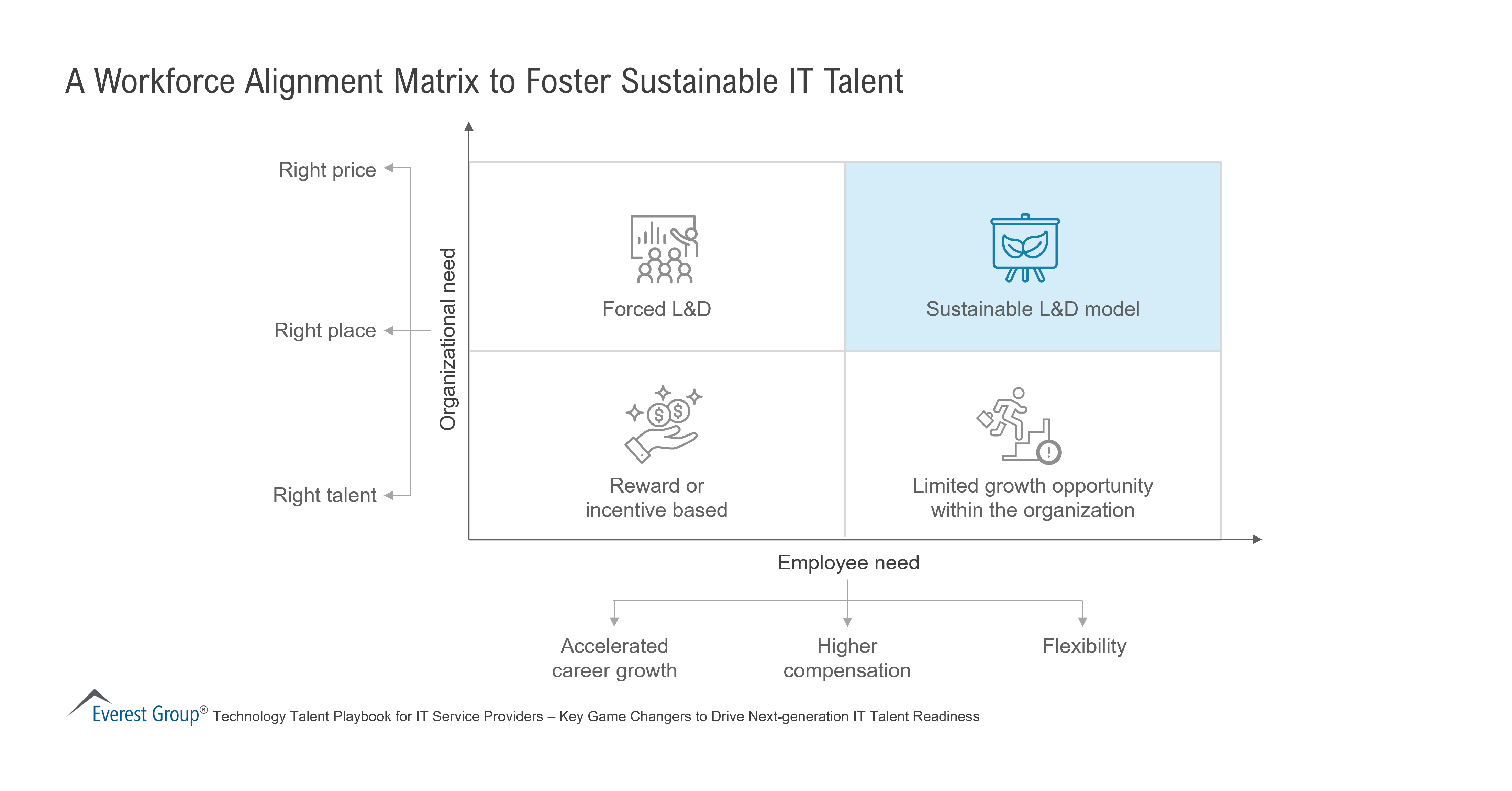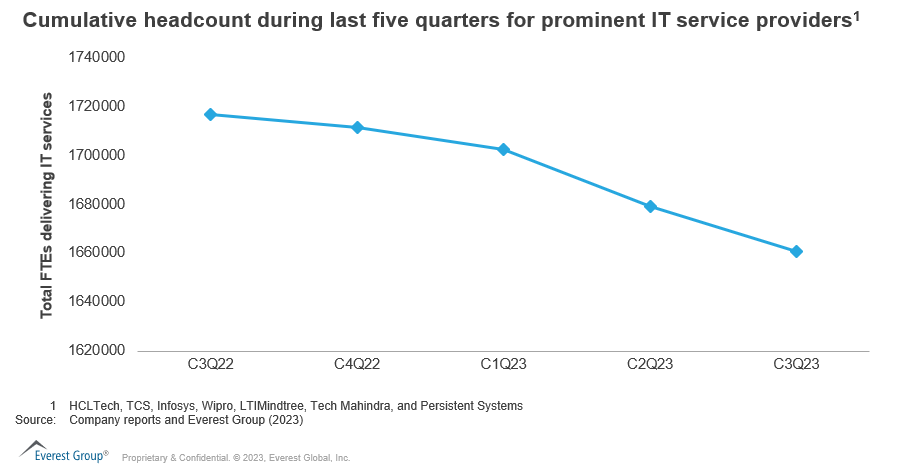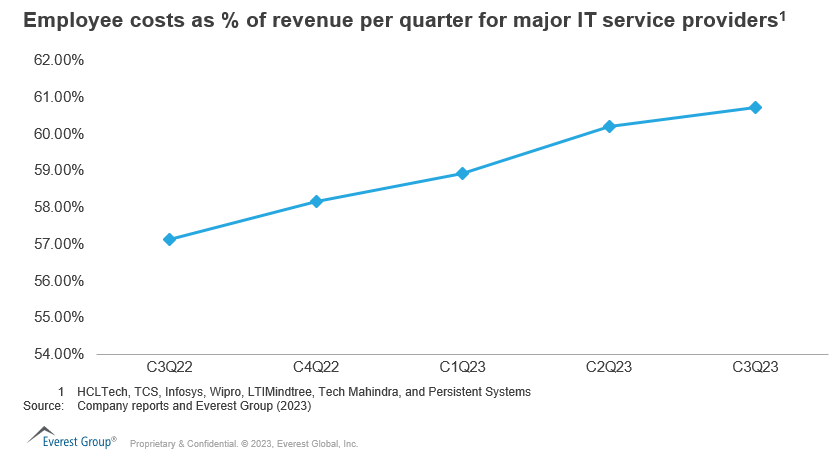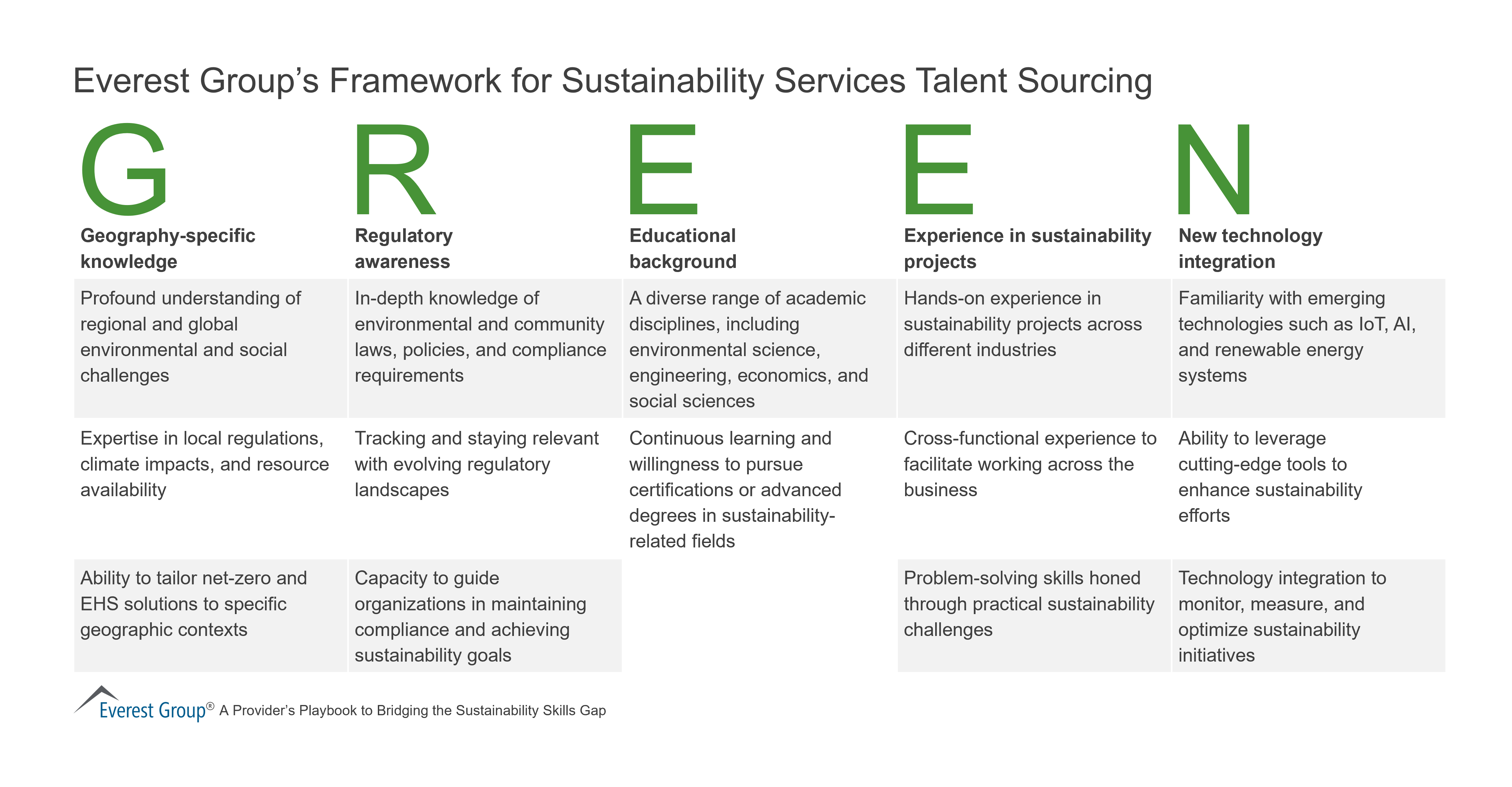IT Talent

View the event on LinkedIn, which was delivered live on Wednesday, February 6, 2024.
Heads of state and governments, top business leaders, global institutions, and civil society convened at the World Economic Forum (WEF 2024) in Davos, Switzerland, on January 15-19, 2024, and discussed pressing global issues and how to act on them. 🌍
Climate change and economic inequity have been critical themes for Davos over the years, and this year’s event was expected to underscore sustainability themes, as well as the proactive role of emerging technologies, such as generative AI, in shaping a responsible future built on trust, collaboration, and sustainable development. 🌱🤝🔍
During this LinkedIn Live, we helped enterprises understand the key takeaways from the WEF annual meeting and the major trends in the climate and sustainability tech and services industry that are changing the marketplace in 2024.
During the event, we explored:
✅ What are leading global enterprises and global institutions doing to drive sustainability, and what’s working? 💡
✅ What are the key demand themes in the market that sustainability leaders across the globe are following to accelerate their path to net zero?
✅ What are the key trends shaping technology and the services market for climate and sustainability?
View the event on LinkedIn, which was delivered live on Thursday, January 18, 2024.
The current scarcity of talent equipped with next-generation technology skills is leading enterprises to rely more on IT service providers for needed capabilities and creating a race for providers to attain top tech talent.
Watch this LinkedIn Live to learn the findings from our recent Talent Readiness for Next-generation IT Services PEAK Matrix® assessment, including insights into the technology talent market, key trends and emerging skills, and the current landscape.
The speakers also discuss IT service providers’ workforce management and development capabilities and talent portfolio rates, as well as provide best-in-class practices that leading IT service providers have adopted to build a sustainable pipeline of high-quality, multi-skilled talent.
What questions does the event answer for the participants?

Technology stands at the forefront in realizing Davos 2024’s vision of “Rebuilding Trust.” By providing innovative strategies and solutions, the technology sector can help address cybersecurity, job creation, artificial intelligence, and climate challenges. For a preview of the critical topics that world leaders will address at the annual event, read on.
As we stand on the precipice of a new year, the global community is gearing up for the World Economic Forum’s annual meeting in Davos. This pivotal event from Jan. 15-19 brings together leaders from across industries to collectively address the world’s most pressing challenges.
In 2024, the spotlight is on “Rebuilding Trust,” with a focus on restoring collective agency and reinforcing fundamental principles of transparency, consistency, and accountability among leaders. Let’s take a glimpse into the themes that will shape the conversations at Davos. Also, see this LinkedIn Live, Pressing Global Issues and Solutions in Tech: Reflections on WEF Davos ’24, for key takeaways from the WEF annual meeting and major trends in the climate and sustainability tech and services industry that are changing the marketplace in 2024.
The overarching theme for Davos 2024 underscores the critical need to rebuild trust in a world marked by fractures and uncertainties. The summit aims to catalyze actionable solutions that transcend borders and industries, placing businesses at the forefront of global collaboration.
Against this backdrop, the role of the technology and technology services sectors takes center stage, offering innovative strategies and solutions to address the following four subtopics outlined for this year’s summit:
In an era of geopolitical complexities, achieving security and cooperation is paramount. The technology sector, with its expertise in cybersecurity and collaborative technologies, has a unique role to play. Beyond safeguarding digital assets, tech can foster global cooperation through secure communication platforms and advanced analytics for early threat detection.
For the technology services sector, the second subtopic hits close to home. The emphasis on creating growth and jobs in a new era aligns with impact sourcing, an inclusive talent strategy that empowers marginalized communities by providing them with meaningful employment opportunities. As we navigate an ever-evolving workforce landscape, technology can be a driving force in fostering inclusive economic growth.
Artificial Intelligence (AI) has already transformed the technology and technology services sectors, and its impact is only poised to expand further. From personalizing training programs to enhancing productivity and offering expanded service offerings, AI is a linchpin in shaping the future of work. Davos provides an unparalleled platform to discuss responsible AI practices that prioritize ethical considerations and human-centric approaches.
The urgency of addressing climate change has never been more evident. The technology sector is pivotal in developing sustainable solutions and innovative approaches to mitigate climate change’s impact. From energy-efficient technologies to data-driven insights for environmental conservation, tech leaders at Davos can forge a path toward a greener, more sustainable future.
As Everest Group anticipates the discussions at Davos, we recognize the transformative role that the technology and technology services sectors can play. By aligning with the summit’s themes and subtopics, the tech industry has the potential to contribute significantly to rebuilding trust and shaping a more inclusive, sustainable, and prosperous global future. for a LinkedIn Live conversation on Feb. 7 with analysts Arpita Dwivedi and Rita N. Soni, and tech expert Marisa Zalabak as we navigate the summit and bring you insights into the pivotal role of technology in achieving Davos 2024’s vision.
Navigating the volatile tech talent market is crucial, but service providers are discovering that finding talent with the needed skillsets is challenging. Read on to discover how leading IT service providers are managing the tech talent turbulence to build a future-ready workforce.
In recent years, the tech talent market has experienced heightened volatility, reflecting the rapidly changing dynamics of the technology landscape. A notable trend during this period has been the record-high attrition rates, especially in niche and specialized roles, indicating a significant turnover of skilled professionals within the industry. Simultaneously, there has been a marked increase in wage inflation, reflecting growing competition for top talent and a scarcity of skilled individuals.
The rapid advancement of technology has created a surge in demand for skilled professionals with expertise in emerging technologies such as artificial intelligence (AI), cybersecurity, cloud computing, and data analytics. However, the supply of qualified talent is struggling to keep pace with this demand, leading to a widening talent demand-supply gap. This gap is further exacerbated by the mismatch between the skills required by employers and the skills possessed by potential employees, demand for industry-specific expertise, geographical imbalances, and the untapped potential of underrepresented groups.
To learn insights into the technology talent market, key trends and emerging skills, and the current landscape, explore this session: Thriving in the Competitive IT Talent Market: Best-in-Class Approaches.
As per Everest Group’s Enterprise Pulse for Technology Services 2023 Report, the percentage of enterprises satisfied with their service partner dropped from 75% to 69%. Twenty-five percent of enterprises remain dissatisfied with the technology and domain expertise of the resource, and 30% express dissatisfaction with their service provider’s talent management capabilities. The key challenges for service providers in building a next-generation ready IT workforce include (listed in order of severity):
In the face of these challenges, the call for talent readiness emerges as a strategic imperative for service providers aiming not just to survive but to thrive in the competitive tech talent market. Talent readiness encompasses more than the ability to recruit; it involves proactive measures to upskill existing employees, anticipate emerging skill requirements, and foster a culture of continuous learning and adaptability.
To assess the talent readiness of IT service providers, we recently launched the Talent Readiness for Next-generation IT Services PEAK Matrix® Assessment 2023. In this PEAK report, we have assessed 26 IT service providers’ workforce management and development practices and their ability to consistently provide quality and hyperproductive talent for next-generation IT services to the client.
In this blog, we’ll delve into the findings of the Talent Readiness for Next-generation IT Services PEAK Matrix® report and highlight best-in-class talent management and development practices adopted by service providers to stay ahead.
In response to the evolving demands of the tech talent market, service providers have demonstrated a proactive approach by making substantial investments to optimize and future-proof their talent supply chain.
Service providers are increasingly adopting innovative approaches to attract and acquire candidates with next-generation skill sets. Embracing non-conventional channels, such as hackathons and case competitions, has become important to identify and engage top talent in a competitive market. Strengthening ties with educational institutions, advocating for close collaboration with academia to align curriculum with market trends, and ensuring that graduates possess the skills in demand will be paramount to shaping the next generation of the tech talent market. Additionally, there is a growing focus on apprenticeship-based hiring, helping service providers with project-ready candidates. For example, one of the leading IT service providers has reported that apprenticeship hires constitute 20% of its entry-level hiring in North America. Furthermore, service providers are tailoring their strategies to specific geographical regions, recognizing the diverse skill landscapes across the globe.
As per the Talent Readiness for Next-generation IT Services PEAK Matrix® report, more than 50% of the service providers mentioned that strengthening the learning and development ecosystem remains their top strategic priority.
Leaders are weighing high on experiential learning, embedding Hackathon, Codeathon, and capstone projects in the learning journey, which will involve the implementation of real business use cases within deadlines, provide the experience to work as a team, and enhance project readiness of the employee. Organizations are leveraging data and AI-based solutions to assess skill gaps and build personalized career and learning pathways to align individual aspirations with broader organizational goals.
To make the learning experience more engaging, gamification and social learning are being embedded into training programs. This not only adds an element of fun but also stimulates healthy competition, motivating employees to actively participate and excel in their learning journeys.
These metrics include tracking learning hours per employee, the number of employees advancing to higher roles post-upskilling, and cross-skilling efforts. Internal mobility is closely monitored to evaluate workforce adaptability, while an employee quotient measures overall competency and deployment. Organizations also assess success by tracking the number of niche skills acquired annually, ensuring they stay abreast of industry trends. Financial considerations, such as spending per employee per year on learning, provide insights into the alignment of investments with skill enhancement and organizational growth. These comprehensive KPIs collectively offer a 360-degree perspective, guiding organizations in refining and innovating their talent development strategies.
According to the Talent Readiness for Next-generation IT Services 2023 report, 22% of the service providers mentioned enhancing employee engagement as their top strategic priority.
In the contemporary workplace landscape, there is an increasingly pressing need for robust employee engagement strategies that prioritize various dimensions of employee well-being. This holistic approach encompasses the physical, mental, financial, and social aspects of an employee’s life.
Leaders have either built or are leveraging third-party AI-based tools to capture employee sentiments, employing advanced sentiment analysis techniques to interpret emotions expressed in various communication channels, including emails, chat logs, and surveys. This continuous tracking and analysis provide organizations with real-time insights into employee morale, satisfaction, and engagement levels. By identifying potential issues such as stress, burnout, or disengagement early on, providers are able to make informed decisions and implement targeted interventions to enhance overall employee well-being and cultivate a positive work environment.
One leading IT service provider utilized AI-based employee engagement solutions, employing a personalized chatbot to conduct pulse and ad hoc surveys and address grievances, thereby performing real-time sentiment analysis and calculating a happiness score in real time.
Beyond internal initiatives, providers are increasingly partnering with technology providers, offering platforms and solutions that can support their talent management efforts. These platforms typically leverage next-generation technologies such as AI and data analytics to enable internal talent mobility, career-pathing, and learning management.
As the pace of technology continues to accelerate, talent is going to be a critical differentiator for providers. To further discuss how you can better prepare your organization, contact [email protected], [email protected], and [email protected]
To learn more about the current IT talent market landscape, check out our session on: Thriving in the Competitive IT Talent Market: Best-in-Class Approaches.
From increased hiring growth after the pandemic to recent layoffs, the tech talent market has experienced great volatility. Recognizing the need for a more sustainable approach, top employers have increasingly focused on building and developing talent internally. In this blog, we examine the major factors contributing to declining tech hiring and the outlook for IT services talent.
Reach out to us to discuss further.
The demand for IT tech talent has fluctuated widely in recent years, moving from a post-COVID hiring surge as enterprises accelerated digital transformation to the challenging Great Resignation, marked by record-high attrition rates and wage inflation.
IT service providers grappled with the dual challenge of retaining skilled professionals and attracting new talent. Now, the pendulum has swung the other way, with organizations implementing rounds of layoffs, imposing hiring freezes, and reducing overall headcount.
This rapid shift underscores the dynamic nature of the tech talent market and the evolving challenges both employers and professionals in this field face. The exhibit below shows the cumulative downward trend in headcount for major IT service providers.

Over the past five quarters, from the second quarter of FY23 to FY24, 56,000 positions were eliminated, translating to an overall 3.26% headcount reduction for this period. This decline contrasts with the significant headcount growth in FY22 and the first half of FY23.
Let’s examine the following major trends contributing to this downward trend and take a look at the talent outlook in the IT services industry:
According to Talent Readiness for Next-generation IT Services PEAK Matrix® Assessment 2023, the strategic priority for the majority of service providers for the next 12 to 18 months from a talent perspective is learning and development. Employers are focusing more on providing best-in-class opportunities for internal talent to upskill/reskill. This effort is backed by implementing structured frameworks to accelerate career progression through internal movement within the firm, aligned with the associates’ aspirations and business requirements.
Consequently, service providers have made significant investments to drive these efforts, including Artificial Intelligence (AI)-based internal talent marketplaces, AI-enabled skill profile matching platforms, personalized skilling recommendations based on an associate’s skill profile, roles, and projects, among others.
The combined result of quality upskilling initiatives and robust internal movement frameworks is that service providers can fulfill a substantial portion of niche talent requirements with specialized skills from their internal talent pool.
One leading service provider reported it has filled 60,000 open positions through upskilled and cross-skilled employees. Additionally, internal mobility also offers multiple other professional benefits, including higher retention rates, lower employee costs, and enhanced succession planning, to name a few
Service providers are focusing on increased internal workforce utilization and optimizing resource allocation to projects. This is evident from the increased utilization rate most service providers have reported in the last few quarters.
Some notable examples include Infosys, where the bench utilization rate increased from 76.6% in the second quarter of FY23 to 80.4% in the same period this year, and Wipro’s bench utilization rate increased from 79.8% to 84.5% during the same period. Additionally, TCS, HCLTech, LTIMindtree, Tech Mahindra, and Persistent Systems also indicated higher bench utilization rates
Due to the ramped-up digital transformation initiatives of enterprise clients during FY22 and the first half of FY23, most service providers ramped up hiring, resulting in significant net new additions to meet the surge in demand.
With the current demand slowing, service providers are focusing on upskilling and rotating already-hired resources. They are cautiously approaching hiring, delaying onboarding, and planning to forego hiring recent college graduates for the current year
Even with the headcount reductions, employee costs are at an all-time high for most of the top service providers. As illustrated in the exhibit below, employee costs have grown faster than revenues in the last few quarters, adversely affecting margins
Apart from this, multiple other factors are affecting margins, including service providers’ back-to-office initiatives. To counter these effects, service providers are focusing on the current internal workforce and significantly ramping down net new additions to lower overall recruitment and onboarding costs.

Current global macroeconomic conditions are significantly contributing to the downward trend. The IT and business process services industry is expected to grow at a slower 2.7-3.2% in year-over-year organic constant currency terms (base case), a deceleration from the 4-6% growth in the last 12 months.
The global economic slowdown, supply chain disruptions, elevated inflation, geopolitical instabilities, wars, and oil conflicts, among other factors, are driving this decline and contributing to a negative outlook.
Hence, enterprises feel obligated to decelerate the pace of transformation initiatives and focus on cost optimization. This leaves the services industry dealing with challenges such as project cancellations, delayed ramp-ups, tougher negotiations, pricing wars, settling for new deals with lower margin profiles, a lack of long-term client commitments, and so on
Over the past few years, service providers have come to a crucial realization that merely relying on external talent acquisition to match enterprise demand is not enough.
Recognizing the need for a more sustainable approach, they have increasingly focused on building and developing talent internally. This shift has given rise to the need to strengthen internal talent development processes.
Consequently, service providers have now started reaping the rewards, efficiently managing a substantial demand volume by leveraging their internal workforce. The benefits extend beyond the organizations themselves, positively impacting employees through enhanced career growth opportunities, skill development, and a sense of loyalty fostered by internal mobility programs.
To gain further insights into how leading IT service providers are tailoring internal talent development and management strategies to drive optimal workforce utilization, manage associate aspirations, and efficiently meet client needs, reach out to Arpita Dwivedi [email protected], Amit Anand [email protected], and Abhigyan Kumar [email protected].
Sustainability Services

Organizational Structuring


©2023 Everest Global, Inc. Privacy Notice Terms of Use Do Not Sell My Information
"*" indicates required fields